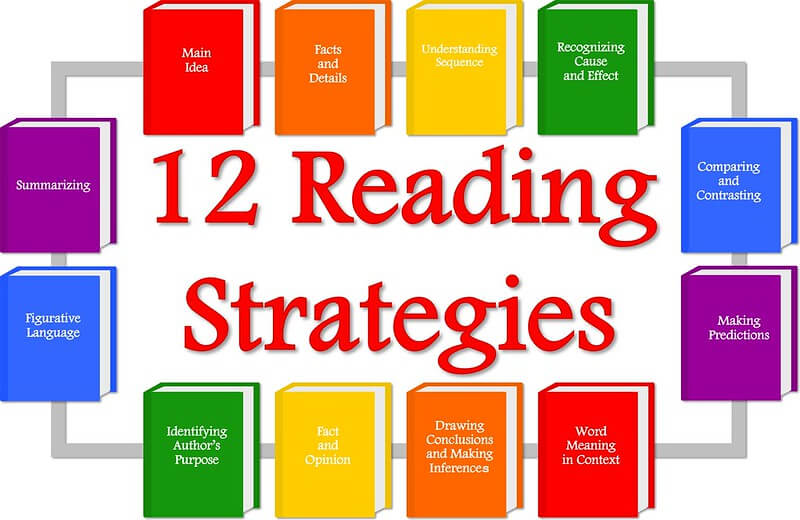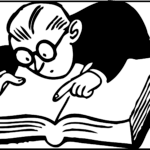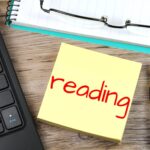12 Reading Strategies to Help With Your Comprehension

Adopting beneficial reading strategies will help you in many ways beyond reading exams and English classes. Every profession needs great readers at the top of them. If you can hone and advance your reading skills, then you will go far in life.
In this article, we’ll be discussing the 12 reading strategies you absolutely must master if you hope to be a good student and long-term successful in life. Let’s begin!
1. Identify the Main Idea
Step one in becoming a great reader is to understand where and how to find the main idea. There are many ways that writers will present these, and it helps to know the overall structure of a paragraph to understand them.
An elementary writing technique is to just state the main idea outright at the beginning or end of the paragraph. News writing often does this through use of the inverted pyramid technique.
However, there is also the use of subversion. In this instance, the writer may start with his illustration and “show” you their point using the principles of storytelling before arriving at the main idea.
As you begin to read, look at the first and last sentences to see if the writer is taking a direct or more leisurely approach. Then, you can begin reading from the start with a better overall understanding.
2. Pull Out Key Facts and Details
Another of the reading strategies that can be helpful to you is to focus on names, places, and numbers. These typically house the key facts and details that the writer will use to make their point.
Try to start each passage by doing a preemptory scan of things. This will tell you where to look for main ideas. It does so by informing the style of the writer.
You might consider this part of the pre-reading process. However, it makes a major impact on how fast you read, as well as your comprehension along the way.
3. Understand Sequence
A third reading strategy that can help is the act of sequencing. Do whatever you can to make sense out of what you’re reading and create a timeline of events.
Sometimes the language will make this easy for you. First, this happened. Then, this. Then, this. But other times, it can be more complicated as the writer gives you information in an order to best make their point rather than to tell a linear history or story.
Being able to pull out information and shuffle it into its proper place on a linear timeline will help you comprehend when you’re being persuaded and when you’re being informed. This recognition makes you a stronger reader.
4. Follow the Cause and Effect
Spotting cause and effect is part of being a good sequencer. If you know how one thing evolves into or causes another, then you’re able to make predictions, exercise your cognitive skills, and draw inferences.
As you’re about to see, all of these factors are important to your effectiveness as a reader. Cause-and-effect can be a difficult principle to understand, but it gets easier when you start simple.
Think about getting up this morning. Your breath probably smelled badly. This caused you to brush your teeth. The fluoride taste of the toothpaste then might have caused you to drink a glass of water, which, in turn, caused you to go to the restroom.
The more you’re able to recognize cause-and-effect in your own life, the easier it will be to recognize it with your reading. Try it with the last thing you read for practice!
5. Compare and Contrast
Comparing and contrasting is another good reading strategy that will lead to better comprehension of what you’re reading as well as completely unrelated subject areas. The best way of establishing your comparing and contrasting skills is to start with two things.
They can be as broad or narrow in scope as you’d like. They can be extremely different or just alike. The act of defining how these things differ or are similar will activate your cognitive thinking skills.
Compare two pieces of fruit, for example. Let’s say a banana and an apple. The banana is shaped like a smile. The apple is roundish. Most bananas are yellow. Most apples are red or green. Apples are hard. Bananas are soft.
Go through each of the five senses to spot as many differences or similarities as you can. Then, do the same whenever what you’re reading reminds you of something else.
6. Make Your Predictions
Predictions don’t have to be right. They don’t even have to be reasonably well-thought-out. You’ll find the act of making predictions will engage your cognitive skills in what you’re reading.
The more that you discover about how right or wrong you are, the more conclusions and understanding you’ll be able to draw from the text. It’s also a cognitive device that will keep you going with your reading when you otherwise might feel like giving up.
7. Look For Context Clues to Decipher Meaning
Building your vocabulary is another of the great reading strategies to make the process more comprehensive. There are two ways you can do this: by looking up the meanings to words you are unfamiliar with, or by figuring out the meaning of those words from the other words and sentences around them.
The latter is far more effective because it forces you to make inferences based on what you do know. It also keeps you in the flow of reading instead of constantly pulling you away from the pages.
As often as you can, avoid the dictionary. Read things closer around the mystery words if they’re slowing you down. Then, try to decide how it’s related to what you do understand.
8. Draw Conclusions and Inferences
This is sort of like making predictions, but it goes a little further than that. When you start drawing conclusions and inferences, you want them to be based on what you’ve comprehended. You also want to be right as much as possible about those conclusions or inferences, or at least to understand why you weren’t.
Good writing can pull the rug out from under you, and if it does, that’s great! But don’t make it easy for the writer to fool you. Be engaged. Try to guess what’s going to happen based on what you already know.
9. Separate Fact From Opinion
Another of the best reading strategies for you to employ is the use of separating fact from opinion. Fact statements provide information. Opinions happen when the writer brings himself or herself into it.
Look for first-person pronouns or inferences and conclusions that the author is trying to lead you towards. Any time you notice persuasive techniques at work, you’re being fed an opinion.
10. Spot the Author’s Motivation
Always be skeptical of the author’s intention. Now, that word “skeptical” sounds negative, but it’s actually a positive in the context of becoming a better reader.
Questioning what you’re reading is how you can put many of the other reading strategies presented here to good use. It’s also how you learn to tell fact from opinion and guard yourself against manipulative tactics.
Ask questions like these: is the author trying to convince or inform? Is he telling me what to think or just sharing information? Going by how this passage/text is written, whom do you believe this individual would vote for in a presidential election, and why?
Walking through questions like these will help you think about what you’re reading from a more critical standpoint. It will help you get to the heart of the passage and improve your understanding.
11. Recognize Figurative Language
Figurative language includes literary devices like similes and metaphors. Think comparing one thing to another through “like” or “as” (similes, “The sun was like a giant lemon in the sky”) or actually redefining one thing as something else (metaphors like “The sun was a giant lemon”).
Authors will use figurative language to make their points in a more concrete and memorable fashion. It’s often used in fiction but shows up quite a bit in other types of formal writing as well.
When you learn to spot figurative language, you’re well on your way to understanding it. You’ll also be able to roll with the comparisons and contrasts in a way that helps the author better make his or her points.
12. Summarize
Perhaps the most powerful of the reading strategies on this list is also the simplest. It’s the act of summarizing what you’ve just read.
Summary is so vital to reading comprehension because it forces the reader to take all the parts they’ve presented and synthesize how that information fits together. The act of summarizing forces you to put it all together, and to do that, you have to understand the parts themselves.
The best way to build your summarization muscles is to start with smaller texts. We often start by identifying the theme in a children’s book before moving onto chapter books and more complex materials. Walk before you run, in other words.
Beyond that, just practice reducing everything you read to its basic message. Make five sentences become one without losing the meaning.
These Reading Strategies Really Work!
Many of the reading strategies we’ve presented here go together or naturally lead into one another. You can’t become good at one without becoming good at a few more. So start at the most accessible point that you can think of, read often, and always be inquisitive about the purpose and message of what you’re reading.
If you can do this, you will become a critical thinker. And critical thinkers go far in whichever profession they choose to call their own. What are the reading strategies that give you the most trouble, and which ones are you the best at? Share your experiences in the comments section below.
[Featured Image by Flickr Creative Commons License]








